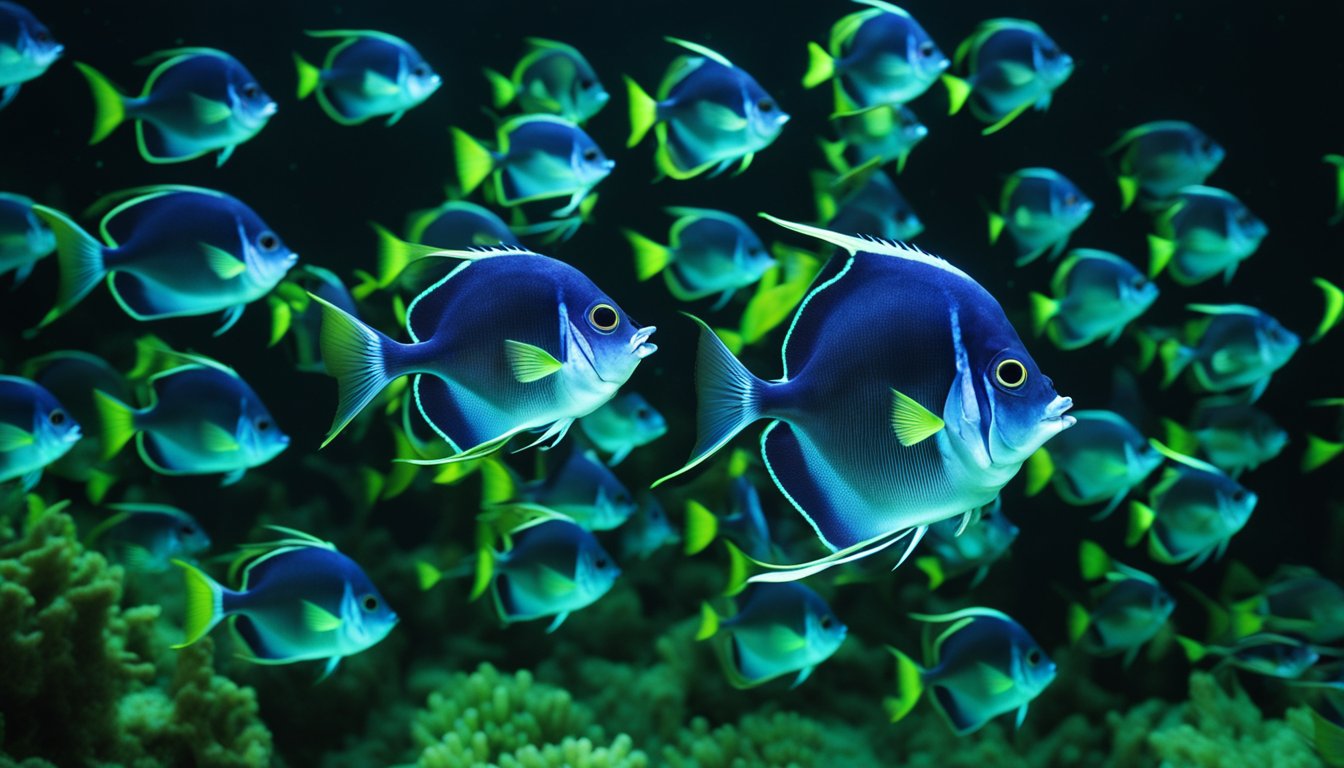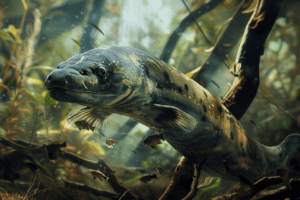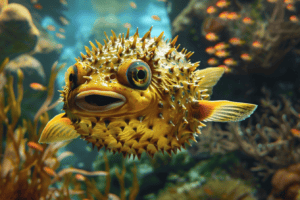Hatchetfish, a group of deep-sea fish, are known for their unique adaptation – bioluminescence.
These fascinating creatures have the ability to produce their own light, which they use to communicate, camouflage, and attract prey.
This phenomenon is known as bioluminescence and is found in a variety of marine organisms.

Bioluminescence is a chemical reaction that occurs when an enzyme called luciferase reacts with a molecule called luciferin, producing light.
In hatchetfish, this process occurs in specialized organs called photophores, which are located on their undersides.
By controlling the intensity and color of the light produced, hatchetfish can blend in with the surrounding water, making them less visible to predators.
Despite their small size, hatchetfish play a crucial role in the deep-sea ecosystem.
They are an important food source for larger predators and help to recycle nutrients in the water column.
The study of bioluminescence in hatchetfish not only provides insight into the evolution of this unique adaptation but also helps us to better understand the complex interactions that occur in the deep sea.
Glowing Seas: The Mystery of Bioluminescence
Bioluminescence is a fascinating natural phenomenon that occurs when living organisms produce light through a chemical reaction.
This magical display of light is found in various creatures, including jellyfish, fireflies, and deep-sea creatures like hatchetfish.
The ability to produce light is an essential adaptation for many marine organisms that live in the deep ocean where sunlight does not penetrate.
Understanding Bioluminescence
Bioluminescence is a complex process that involves the interaction of two chemicals: luciferin and luciferase.
Luciferin is a light-emitting molecule, while luciferase is an enzyme that triggers the chemical reaction that produces light.
When luciferin and luciferase come into contact, they react and produce a bright glow.
Scientists are still trying to understand the exact mechanism behind bioluminescence.
However, they have discovered that the process is highly regulated and controlled by the organism’s genetic makeup.
This means that different species of bioluminescent creatures produce different colors and patterns of light.
The Role of Luciferin and Luciferase
Luciferin and luciferase are found in various marine organisms, including bacteria, plankton, and deep-sea fish.
In hatchetfish, the light-producing organs are located on their bellies, and they use the light to camouflage themselves from predators below.
The hatchetfish’s bioluminescent display is also used to attract prey and communicate with other members of their species.
The light produced by hatchetfish is blue-green, which is the most visible light in the deep ocean.
This allows them to see each other and communicate without being seen by predators.
In conclusion, bioluminescence is a mysterious and captivating natural phenomenon that has evolved over millions of years.
The ability to produce light is an essential adaptation for many marine organisms that live in the deep ocean.
By understanding the mechanisms behind bioluminescence, scientists can gain insights into the evolution and ecology of these fascinating creatures.
Hatchetfish: Masters of Light

Hatchetfish are a family of deep-sea fish that are named after their unique shape, which resembles a hatchet.
These fish are known for their incredible ability to produce light, also known as bioluminescence, which they use for various purposes.
In this section, we will explore the amazing world of hatchetfish and their mastery of light.
Species Spotlight: The Deep-Sea Hatchetfish
Hatchetfish are found in the deep waters of the ocean, where sunlight does not penetrate.
They are small in size, ranging from 1 to 15 centimeters in length, and have a flattened body that is silver or black in color.
Their eyes are large and are located on the top of their head, which allows them to see both above and below them.
One of the most fascinating characteristics of hatchetfish is their unique adaptation to their environment.
They have a special organ called a photophore, which is used to produce light.
The photophores are located on different parts of their body, such as their head, sides, and belly.
By controlling the intensity and location of their light, hatchetfish can camouflage themselves from predators or attract prey.
Bioluminescence for Survival
Hatchetfish use their bioluminescence for a variety of reasons. One of the most important uses is for communication.
They use their light to signal to other hatchetfish, either to attract mates or to warn of danger.
Another use of their bioluminescence is for hunting. Hatchetfish are carnivorous and feed on smaller fish and invertebrates.
They use their light to attract prey and then quickly strike with their sharp teeth.
Hatchetfish also use their bioluminescence for defense. When threatened, they can produce a bright flash of light to startle predators and escape.
In conclusion, hatchetfish are truly masters of light.
Their ability to produce and control bioluminescence is a remarkable adaptation that has allowed them to survive in the dark depths of the ocean.
By learning about these fascinating fish, we can gain a better understanding of the incredible diversity of life on our planet.
Observing Bioluminescence

Bioluminescence is a fascinating natural phenomenon that occurs when living organisms emit light.
Hatchetfish, a type of deep-sea fish, are known for their bioluminescent abilities.
Observing bioluminescent hatchetfish can be an exciting and educational experience for both children and adults alike.
Where to Find Bioluminescent Hatchetfish
Hatchetfish are typically found in the deep waters of the ocean, between 200 and 1500 meters deep.
They are most commonly found in the Atlantic, Pacific, and Indian Oceans. However, hatchetfish can also be found in aquariums around the world.
To observe bioluminescent hatchetfish in the wild, one would need to go on a deep-sea diving expedition.
This can be an expensive and dangerous undertaking.
Alternatively, one can observe hatchetfish in aquariums, where they are often kept as exhibits.
Hatchetfish in Aquariums
Many aquariums around the world have hatchetfish exhibits. These exhibits allow visitors to observe these fascinating fish up close.
Hatchetfish in aquariums are typically kept in tanks with dim lighting to better showcase their bioluminescent abilities.
When observing hatchetfish in aquariums, it is important to be patient and observant.
Hatchetfish are known for their shyness and may take some time to become active in their tank.
Once they do become active, they will often emit a bright blue-green light, which can be mesmerizing to watch.
In conclusion, observing bioluminescent hatchetfish can be a fun and educational experience.
Whether in the wild or in an aquarium, hatchetfish are fascinating creatures that are sure to spark curiosity and wonder about the natural world.
Frequently Asked Questions

How do hatchetfish use their bioluminescence to survive in the deep sea?
Hatchetfish use their bioluminescence to communicate with other fish, attract prey, and avoid predators.
They have light-producing organs called photophores located all over their bodies, which they can control to produce different patterns and intensities of light.
Hatchetfish use their bioluminescent light to blend in with the light coming from above, making them less visible to predators below.
Can you tell me about other creatures of the deep that light up like the hatchetfish?
Yes, there are many other creatures of the deep that use bioluminescence to survive. Some examples include anglerfish, lanternfish, and vampire squid.
Each of these animals has its unique way of using bioluminescence to hunt, communicate, and avoid danger.
What’s the secret behind the glow of bioluminescent marine life?
The glow of bioluminescent marine life comes from a chemical reaction that takes place inside their bodies.
The reaction involves a molecule called luciferin and an enzyme called luciferase. When these two substances combine, they produce light.
Bioluminescent organisms can control the intensity and the color of the light they produce by adjusting the concentration and location of their photophores.
How does bioluminescence help animals in the dark ocean depths?
Bioluminescence helps animals in the dark ocean depths by providing a way to communicate, find food, and avoid danger.
In the deep sea, where sunlight does not penetrate, bioluminescence is the only source of light.
Many animals have evolved to use bioluminescence as a way to attract mates, confuse predators, and lure prey.
Are there any dangers associated with bioluminescent organisms for humans?
While bioluminescent organisms are fascinating to observe, some of them can be dangerous to humans.
Some species of bioluminescent plankton, for example, can cause red tides, which can lead to respiratory problems and skin irritation.
Additionally, some bioluminescent fish, such as the fangtooth, have sharp teeth and venomous spines that can cause injury.
What role does bioluminescence play in the ecosystem of hatchetfish?
Bioluminescence plays a crucial role in the ecosystem of hatchetfish. It helps them hunt for food, communicate with other fish, and avoid predators.
Without bioluminescence, hatchetfish would be at a significant disadvantage in the deep sea.
Bioluminescence also plays a vital role in the food chain, as hatchetfish are preyed upon by larger fish, which in turn are preyed upon by even larger fish.









